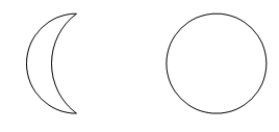Correct Answer

verified
Correct Answer
verified
Multiple Choice
The sun is on the celestial equator at the times of the
A) vernal equinox and the summer solstice.
B) autumnal equinox and the vernal equinox.
C) summer solstice and the winter solstice.
D) autumnal equinox and the winter solstice.
E) sun is on the ecliptic and is never on the celestial equator.
Correct Answer

verified
Correct Answer
verified
True/False
The path of totality for a solar eclipse is swept out by the tip of the moon's umbra as the umbra moves over Earth.
Correct Answer

verified
Correct Answer
verified
True/False
Precession of Earth's axis causes the date at which perihelion of Earth's orbit occurs to slowly change.
Correct Answer

verified
Correct Answer
verified
Multiple Choice
The ____ of the moon is the period of time for the moon to complete a cycle of the lunar phases and is approximately 29.5 days long.
A) sidereal period
B) saros cycle
C) synodic period
D) eclipse season
E) umbral period
Correct Answer

verified
Correct Answer
verified
True/False
The seasons are caused by the precession of Earth's axis.
Correct Answer

verified
Correct Answer
verified
Short Answer
The ____________________ period (or "month") of the moon is the time required for one revolution of the moon around Earth with respect to the stars.
Correct Answer

verified
Correct Answer
verified
Essay
How can tidal forces affect the rotation of celestial bodies and their orbital motion?
Correct Answer

Answered by ExamLex AI
Tidal forces can affect the rotation of ...View Answer
Show Answer
Correct Answer
Answered by ExamLex AI
View Answer
Multiple Choice
A(n) ____ is a set of beliefs that appears to be based on scientific ideas, but which fails to obey the most basic rules of science.
A) theory
B) hypothesis
C) pseudoscience
D) allegory
E) scientific model
Correct Answer

verified
Correct Answer
verified
True/False
The third quarter moon rises at noon.
Correct Answer

verified
Correct Answer
verified
Multiple Choice
Earth doesn't experience a solar eclipse every month because
A) of unpredictable weather patterns.
B) the moon always keeps its same side toward the Earth.
C) the moon's orbit plane is not aligned with the Earth's orbit plane.
D) its sometimes nighttime when the eclipse occurs.
E) sometimes the moon is too far away.
Correct Answer

verified
Correct Answer
verified
Multiple Choice
The figure shows the ______ and _____ moon phases.. 
A) crescent; first quarter
B) new; new
C) crescent; full
D) first quarter; full
Correct Answer

verified
Correct Answer
verified
Multiple Choice
If the moon's orbital plane was aligned with the celestial equator we could
A) have eclipses every month.
B) never have eclipses.
C) have eclipses only at solstice.
D) have eclipses only at the equinoxes.
Correct Answer

verified
Correct Answer
verified
Short Answer
What would you see if you were on the moon and facing Earth when people on Earth saw a total lunar eclipse?
Correct Answer

Answered by ExamLex AI
If you were on the moon facing Earth dur...View Answer
Show Answer
Correct Answer
Answered by ExamLex AI
View Answer
Multiple Choice
Assume all else is unchanged, and the Earth's rotational axis is perpendicular to the ecliptic. As a result, seasonal variations on the Earth would
A) be practically non-existent.
B) remain the same as they are at now.
C) have the same severity but each season would last twice as long.
D) be much more severe.
Correct Answer

verified
Correct Answer
verified
Multiple Choice
A lunar eclipse that occurs when the moon moves completely into Earth's umbral shadow is called
A) a total solar eclipse.
B) a partial solar eclipse.
C) an annular eclipse.
D) a penumbral lunar eclipse.
E) a total lunar eclipse.
Correct Answer

verified
Correct Answer
verified
Not Answered
Explain why people who live close to the equator do not experience major changes in the seasons.
Correct Answer

verified
Correct Answer
verified
Multiple Choice
The ____ moon is visible above the eastern horizon a couple of hours before sunrise.
A) waning gibbous
B) waxing gibbous
C) waxing crescent
D) waning crescent
E) new moon
Correct Answer

verified
Correct Answer
verified
Multiple Choice
On the vernal equinox the sun is
A) 23° north of the celestial equator.
B) 23° south of the celestial equator.
C) on the celestial equator and moving north with respect to the equator.
D) on the celestial equator and moving south with respect to the equator.
E) closest to the north celestial pole.
Correct Answer

verified
Correct Answer
verified
Short Answer
A(n) ____________________ eclipse occurs when the moon is at its greatest distance from Earth and the moon is new and at a node in its orbit.
Correct Answer

verified
Correct Answer
verified
Showing 81 - 100 of 116
Related Exams